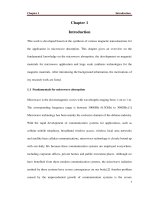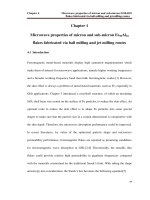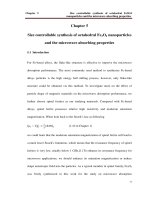Synthesis of various magnetic nanostructures and the microwave characterizations 2
Bạn đang xem bản rút gọn của tài liệu. Xem và tải ngay bản đầy đủ của tài liệu tại đây (976.28 KB, 19 trang )
Chapter 2 Characterization techniques
26
Chapter 2
Experimental techniques
2.1 Materials synthesis
2.1.1 Preparation of Fe/SiO
2
core-shell particles by Stöber process
Fe/SiO
2
core-shell particles were prepared by a Stöber process.[1] Firstly, the raw
commercial carbonyl iron powder was added into a mixture solution of anhydrous
ethanol (160 ml) and water (40 ml). Then 3ml ammonia solution (NH
3
•H
2
O) and 4 ml
tetraethyl orthosilicate (TEOS) were added to the solution. After magnetic stirring
about 12 hours, another 2 ml TEOS and 1 ml NH
3
•H
2
O were added with continuous
magnetic stirring for another 6 hours. Finally, the product was washed three times
with anhydrous ethanol and dried at room temperature.
2.1.2 Preparation of Fe/Al flakes by ball milling and jet milling
The starting materials are commercial iron powder and aluminum powder. Fe and Al
powders were weighted and mixed in the nominal composition of Fe
90
Al
10
. Prior to
morphology modification process, the solid solution of Fe(Al) was first obtained by a
dry milling process by an 8000M-230 Spex mixer for 12 h. The steel balls with
diameter of 6 mm were used for grinding. The ball to powder weight ratio was 50:1.
The collected powder was named as sample S0, it consisted of non-uniform Fe(Al)
Chapter 2 Characterization techniques
27
particles with irregular shapes. A second step was wet milling for the preparation of
micron flaky particles. On the one hand, sample S0 was dissolved into anhydrous
ethanol and further milled for 0.5 h and 5 h, separately. The products were
correspondingly named as Sample S1 and Sample S2. On the other hand, sample S0
was milled by the Micron-Master Jet Pulverizer (Model 02-612-WC). The jet milling
period is determined by the gas pressure provided by the air compressor. The pressure
is set at 4 bars in our system. After jet milling, two kinds of products could be
received due to their weight difference. The one is flaky Fe/Al powders in submicron
scale (Sample S3), which are relatively light and accumulate on the top layer of the
receiver. The other is spherical Fe/Al powders (Sample S4), which are relatively
heavy and fall onto the bottom of the receiver after milling. Fig. 2.1 shows the photo
image of the jet miller systems. Besides the jet milling machine, air compressor and
Jet miller
Air drier
Air compressor
Fig. 2.1 Photo image of the jet miller systems including air compressor, air drier
as well as jet milling machine.
Chapter 2 Characterization techniques
28
air drier are indispensable accessories.
2.1.3 Synthesis of Fe
3
O
4
nanoparticles by thermal decomposition method
In the synthesis of Fe
3
O
4
nanoparticles, iron(III) acetylacetonate [Fe(acac)
3
] and oleic
acid were added to benzyl ether. The mixture was purged with nitrogen gas for 30 min
to remove air at room temperature, then slowly heated to 165 ℃ for 30 min, and
further heated to 280 ℃ to reflux the mixture for 30 min. The mixture was cooled
down to room temperature after reaction. Finally, Fe
3
O
4
nanoparticles were separated
by centrifugation in toluene solvent. For the separation of nanoparticles smaller than
20 nm, the mixture of hexane and ethanol with volume ratio of 1:2 was used as the
solvent for centrifugation.
The particle size was controlled by adjusting the amount of Fe(acac)
3
precursor while
keep the amounts of oleic acid and benzyl ether constant. Table 2.1 listed the amounts
of starting materials for the synthesis of Fe
3
O
4
nanoparticles with sizes ranging from 6
Table 2.1 The amounts of starting materials for synthesis of Fe
3
O
4
nanoparticles
with different sizes.
Particles size (nm)
Starting materials
6
8
18
21
53
114
430
Fe(acac)
3
(mmol)
8
10
11
12
14
16
24
Oleic acid (mmol)
40
40
40
40
40
40
40
Benzyl ether (mL)
50
50
50
50
50
50
50
Chapter 2 Characterization techniques
29
nm to 430 nm.
2.1.4 Synthesis of Zn-ferrite nanoparticles by thermal decomposition method
Table 2.2 The amounts of starting material for the synthesis of Zn-ferrite nanoparticles
with various compositions and sizes.
Sample
No.
Fe(acac)
3
(mmol)
Zn(acac)
2
(mmol)
Yielded composition
( from EDS)
Oleic acid
(mmol)
Benzyl ether
(mL)
ZF0
12
0
Fe
3
O
4
28
20
ZF1
12
2
Zn
0.189
Fe
2.811
O
4
28
20
ZF2
12
4
Zn
0.290
Fe
2.710
O
4
28
20
ZF3
12
6
Zn
0.387
Fe
2.613
O
4
28
20
ZF3_26.5
8
4
Zn
0.38
Fe
2.62
O
4
28
20
ZF3_13.4
7.2
3.6
Zn
0.38
Fe
2.62
O
4
28
20
ZF4
12
8
Zn
0.468
Fe
2.532
O
4
28
20
ZF5
12
10
Zn
0.522
Fe
2.478
O
4
28
20
ZF6
12
12
Zn
0.524
Fe
2.476
O
4
28
20
ZF7
12
14
Zn
0.527
Fe
2.472
O
4
28
20
Note: The particle sizes of samples ZF0 to ZF7 are all around 100nm, while the particle
sizes of samples ZF3_26.5 and ZF3_13.4 are 26.5 nm and 13.4nm, respectively.
In the synthesis of Zn-ferrite nanoparticles, both of iron(III) acetylacetonate
[Fe(acac)
3
] and zinc acetylacetonate hydrate [Zn(acac)
2
·xH
2
O] were used as the
precursors and dissolved into benzyl ether. Oleic acid was added as the surfactant.
The mixture was heated to 120 ℃ and kept for 30 min to eliminate the bonding
Chapter 2 Characterization techniques
30
water from precursors and finally heated to 280 ℃ at a rate of 8 ℃/min to reflux the
mixture for 30 min. The gray-black precipitates were collected by magnetic separation
after the mixture was cooled down to ambient temperature naturally, and then washed
by organic solvent (toluene or hexane) for several times. The molar ratio of
Zn(acac)
2
·xH
2
O to Fe(acac)
3
was adjusted to control the composition of
as-synthesized Zn-ferrite, as listed in Table 2. Samples ZF0 to ZF7 were numbered
according to the ratio of Zn/Fe precursors varying from 0 to 1.25. The size of
Zn-ferrite particles were controlled by scaling down/up the total amount of precursors.
Take sample ZF3 for example. The particle size of sample ZF3 was about 104 nm.
When the amounts of iron and zinc precursors were scaled down to 8 mmol and 4
mmol, respectively, the particle size of as-synthesized Zn-ferrite would reduce to 26.5
nm, thus this sample was named as ZF3_26.5. Similarly, Zn ferrite particles with size
of 13.4 nm (sample ZF3_13.4) were obtained by further scaling down the iron and
zinc precursors to 7.2 mmol and 3.6 mmol.
2.1.5 Synthesis of Fe
3
O
4
nanoparticles via chemical reduction of α-Fe
2
O
3
template
2.1.5.1 Synthesis of α-Fe
2
O
3
nanoparticles with various shapes by hydrothermal
route
-Fe
2
O
3
nanoparticles were synthesized by a hydrothermal treatment of FeCl
3
6H
2
O
(Sigma) in the presence of NH
4
H
2
PO
4
(Sigma). For a typical synthesis of 110 nm
Chapter 2 Characterization techniques
31
-Fe
2
O
3
nanorods, specific amount of FeCl
3
and NH
4
H
2
PO
4
aqueous solutions were
mixed together. Then distilled water was added to the mixed solution to keep the final
volume at 75 mL. After vigorous stirring for 30 minutes, the mixture was transferred
into a Teflon-lined stainless-steel autoclave with a capacity of 125 mL for
hydrothermal treatment at 220 ℃ for 48 h. Then the autoclave was cooled down to
room temperature naturally. The produced red precipitate was separated by
centrifugation, then washed with absolute ethanol for 3 times, finally dried in oven at
60 ℃. More than 100mg -Fe
2
O
3
nanorods powder could be obtained after one
single batch of experiment. The -Fe
2
O
3
nanoparticles with different morphologies
and sizes could be fabricated by adjusting the amounts of aqueous FeCl
3
solution and
aqueous NH
4
H
2
PO
4
solution, as well as the volume of distilled water. In order to
prepare -Fe
2
O
3
nanoparticles with different structures, a serial of experiments were
designed, as listed in table 2.3.
2.1.5.2 Synthesis of Fe
3
O
4
nanoparticles via chemical reduction method using
α-Fe
2
O
3
nanoparticles as templates
The -Fe
2
O
3
templates (100 mg) were dispersed into 35mL of trioctylamine (TOA)
solvent after ultrasonication for 2 h. Then oleic acid (3.5 g) was added to the mixture
and the final solution was transferred into a 100 mL three-neck flask with reflux
condenser. The reaction was performed at 350 ℃ for 1 h, then cooled down. The
precipitates were collected and centrifuged with hexane (or toluene) for 3 times and
dried at room temperature. The whole process was under a flow of gas and with
Chapter 2 Characterization techniques
32
vigorous stirring. Pure Ar gas and a mixed gas involving 95%Ar with 5%H
2
were
employed for different reduction processes. The gas flow rate was controlled by a gas
Table 2.3 Synthesis conditions for -Fe
2
O
3
nanoparticles
with various shapes and sizes
Samples
FeCl
3
6H
2
O
(×10
-3
M)
NH
4
H
2
PO
4
(×10
-3
M)
Total volume
(mL)
Outer diameter
(nm)
Length
(nm)
154-ring
5
0.72
40
154 ± 15
117 ± 12
117-ball
20
1.44
40
117 ± 12
74-ring
10
0.36
40
74 ± 9
64 ± 9
70-tube
20
0.72
40
70 ± 10
363 ± 79
120-rod
26.7
0.48
30
120 ± 14
366± 55
98-rod
20
0.36
40
98 ± 8
244 ± 25
61-rod
13.3
0.24
60
61 ± 5
136 ± 21
55-rod
10.7
0.192
75
55 ± 4
113 ± 11
Note: The size of
-Fe
2
O
3
particles is labeled according to the average value of outer
diameter.
mass flow meter with a maximum rate of 200 sccm (i.e. mL/min). After the chemical
reduction process, the morphology of the -Fe
2
O
3
templates could be well preserved.
Therefore, the size and shape of as-obtained Fe
3
O
4
nanoparticles were totally
determined by that of the -Fe
2
O
3
templates.
The above synthesis processes were all employed by this work. The as-synthesized
products were further characterized through different measurements. The following
Chapter 2 Characterization techniques
33
part would introduce the characterization methods and the sample preparation
procedures for various characterizations.
2.2 Materials characterizations
2.2.1 Structural and microstructural analysis
2.2.1.1 X-ray Diffraction (XRD)
The phase structure of crystals could be examined by means of X-ray diffraction. The
instrument for X-ray diffraction involves an X-ray source and an X-ray detector. The
incident X-ray beams are emitted from the source and impinges onto the solid
samples. For a crystalline solid consisting of a regular array of atoms, the X-rays will
be scattered from lattice planes separated by the interplanar distance and the signal
received by the detector. As shown in Fig. 2.2, when two X-ray beams are scattered,
they remain in phase since the path length of each ray is equal to an integer
multiple of the wavelength. The path difference between the two
beams is given by . When they interference constructively, Bragg’s condition
should be fulfilled as[2]
(2.1)
where is an integer corresponding to the order of the diffraction plane, is the
wavelength of the incident X-ray beams, is the distance of two adjacent diffraction
planes and is the incident angle (or scattering angle) of X-ray beams relative to the
Chapter 2 Characterization techniques
34
diffraction planes (the black dash lines in Fig. 2.2). A diffraction pattern is obtained by
recording the intensity of scattered X-ray beams as a function of scattering angle. The
peaks in the X-ray diffraction patterns are corresponding to a set of the crystalline
orientations ( values) of a given material, which is used to characterize the phase
structure with referring to the existing diffraction files (PDF) compiled by the Joint
Committee of Powder Diffraction Standards (JCPDS).
In this work, phase examination was performed using a Bruker D8 Advance X-ray
diffractometer (
radiation, . The to scan was adopted with
the 2 angel ranging from 10° to 90° in the step of 0.02°.
Besides the phase confirmation, the crystalline size of the polycrystalline powder
materials can be estimated using the Scherrer equation:[3]
(2.2)
where is shape factor (for spherical shape particles, ), is X-ray
wavelength, is line broadening at half the maximum intensity (FWHM) in radians
Fig. 2.2 Schematic diagram of X-ray diffraction by a crystal.
Chapter 2 Characterization techniques
35
and is scattering angle. D is mean diameter of crystallines, which may smaller or
equal to the grain size. To be noted, the Scherrer equation is limited to nano-scale
particles with grain size less than 100 nm.
Sample preparation for XRD measurement
For Fe/Al alloys, the powders are dispersed in ethanol and ultrasonicated for half an
hour. Then the solvent is taken out with pipette and dropped on glass substrates. After
the ethanol volatilizes away, the samples are ready for measurement. The same
procedure is applied to the sample preparation of Fe
3
O
4
and Zn-ferrite nanoparticles
for XRD measurement except that the solvent of toluene is used instead of ethanol.
2.2.1.2 Scanning Electron Microscopy (SEM) and Energy-Dispersive X-ray
Spectrometer (EDS)
SEM is a type of electron microscope that produces images of a sample by scanning it
with a focused beam of electrons. The electrons interact with the electrons within the
material, producing various signals that can be detected and that contain information
about the sample’s surface topography and composition. The types of signal produced
include secondary electrons (SE), back-scattered electrons (BSE), primary electrons
and characteristic X-rays.
The morphology and composition of the samples were detected by a Field-emission
scanning electron microscopy (FESEM; Zeiss Supra 40) equipped with an
Chapter 2 Characterization techniques
36
Energy-Dispersive X-ray Spectrometer (EDS). The Inlens detector was used for
taking images at magnifications of 250x to 1,000,000x. The work distance was tuned
between 3 to 5 mm. The working voltage could be adjusted. The commonly used
voltage was 5 kV. The EDS should be operated in the SE mode. And the work
distance was kept at 8 mm. The working voltage could be adjusted to fulfill a
deadtime of 20% ~ 30%, which was good for signal collection. EDS spectra in the
kinetic energy range of 0.1 keV to 20 keV were acquired for measured samples.
Sample preparation for SEM and EDS measurement
Similar with the sample preparation for XRD measurement, Fe/Al alloys are dispersed
in ethanol, while Fe
3
O
4
and Zn-ferrite are dispersed in toluene. Dilute solutions are
required for SEM measurement. After ultrasonication for a while, the solvent is taken
out with pipette and dropped on Si wafer substrate. After the liquid (ethanol or toluene)
volatilize away, the samples are ready for measurement.
2.2.1.3 Transmission Electron Microscopy (TEM)
TEM is a sophisticated microscopy technique which can be used to obtain detailed
microstructural information by high-resolution and high-magnification images or
crystal structure information by diffraction patterns. Fig. 2.3 demonstrates the two
operation modes of TEM, i.e. diffraction mode and imaging mode, depending on the
used aperture.[4] When the electrons emitted are accelerated by the high voltage
source, they can pass through the specimen. The electrons will be diffracted or
Chapter 2 Characterization techniques
37
scattered by the atoms within the specimen. A SAED aperture (or an objective
aperture) is used in the diffraction mode (or imaging mode) to differentiate those
electrons, determining which electrons configurate the image. In the diffraction mode,
the image is configurated by the electrons which can fulfill the Bragg’s condition in
Eq. (2.1). The resultant image is either polycrystalline rings or single crystalline dots,
as shown in Fig. 2.4. The lattice spacing of the specimen could be determined from
the diffraction patterns[5]
(2.3)
Fig. 2.3 Schematic illustration of different working modes of transmission electron
microscopy: (a) diffraction mode and (b) imaging mode.
Chapter 2 Characterization techniques
38
where is camera length,
is electron wavelength, is radius of the diffraction
rings (for polycrystalline) or distance between diffraction spots (for single crystalline).
In this work, a transmission electron microscopy (TEM, JEOL-2010 at 200 kV) was
employed to detect the morphology, size and crystal structure of the nanoparticles.
Both high resolution images and selected area electron diffraction (SAED) patterns
were acquired.
Sample preparation for TEM measurement
Fe
3
O
4
/Zn-ferrite nanoparticles should be well dispersed in toluene prior to the sample
preparation. Very dilute solution was required to get good TEM images. On drop of
the diluted solution was taken out by pipette and dropped onto the carbon-coated
copper grid for observation.
2.2.1.4 X-ray Photoelectron Spectroscopy (XPS)
XPS is a quantitative spectroscopic technique which is used to measure the elemental
Fig. 2.4 Typical diffraction patterns for (a) single crystalline structure and (b)
polycrystalline structure.
Chapter 2 Characterization techniques
39
composition and chemical state of elements within a material. XPS spectra are
obtained by irradiating a solid material with monoenergetic soft X-ray beams while
simultaneously measuring the kinetic energy and number of electrons which escape
from the top 1 ~ 10 nm of the material. The resultant kinetic energy () of the
electrons can be measured as[6]
(2.4)
where is the energy of the photon, is the binding energy of the atomic orbital
from which the electron escapes and
is spectrometer work function. Each element
has a characteristic spectrum.
In this work, the chemical states of iron were investigated by X-ray photoelectron
spectroscopy (XPS, ESCA LAB 220i-XL spectrometer). The energy source was a
non-monochromatic magnesium X-rays corresponding to a photon energy of 1253.6
eV. The total energy resolution was 900 meV. The XPS spectra were fitted by XPS
peak4.1 software.
Sample preparation for XPS measurement
All the measured samples are powders. Put a little bit of powder onto the carbon
conductive tape on the sample holder. For each sample, the covered area of the
conductive tape by the powder is about .
Chapter 2 Characterization techniques
40
2.2.2 Magnetic properties characterizations
2.2.2.1 Vibrating Sample Magnetometer (VSM)
VSM measures the magnetic properties of samples using an induction technique. Fig.
2.5 shows the schematic illustration of a VSM system. During the measurement, the
sample is placed on a sample holder in between the two electromagnets and oscillated
at a constant frequency in a vertical direction driven by a resonator. The
oscillation of the magnetic sample under a magnetic field leads to the change in
magnetic flux, which induces an alternating voltage in the pick-up coils according to
Faraday’s law of induction.[7] The effective voltage could be given by
(2.4)
where is the induced alternating voltage, which is detected and amplified using a
lock-in amplifier, and then transferred to the magnetic moment of sample by linking
to proper electric circuit. is the magnetic moment of the sample and is a
coefficient determined by the calibration of a nickel standard sample.
The magnetic hysteresis loop (M-H loop) is the common form of the recorded data.
From a M-H loop, we can read the saturation magnetization
, the remanence
,
the coercivity
and so on. For the materials under this study,
is a most
concerned parameter. Vibrating sample magnetometer (VSM; Lakeshore, Model 7404)
was used in this work to collect the room temperature M-H loops of as-prepared
Chapter 2 Characterization techniques
41
magnetic particles. Before the measurement, a moment gain calibration was
performed to make sure the accuracy of the obtained
value. A nickel ball with a
moment value of 6.92 emu/g under the magnetic field of 5 kOe was used as the
standard sample. In the measurement, the full M-H loops were recorded by slowing
sweeping the applied magnetic field from a maximum positive field (20 kOe) to a
maximum negative field (-20 kOe) and reversing to the maximum positive field (20
kOe).
Sample preparation for VSM measurement
Magnetic powders (~ 10 mg) were required to be wrapped in the aluminium foil
before the measurement. Write down The weight of the powders was written down for
further calculation of the magnetic moment per unit mass.
2.2.2.2 Mössbauer spectroscopy
Mössbauer spectroscopy is a spectroscopic technique based on the Mössbauer effect.
Fig. 2.5 Schematic illustration of a VSM system.
Chapter 2 Characterization techniques
42
This effect consists of the recoil-free, resonant absorption and emission of gamma
rays in solid. It can probe tiny changes in the energy levels of an atomic nucleus in
response to its environment. Typically, three types of nuclear interaction may be
observed, i.e. isomershift, quadrupole interactions and magnetic splitting.[8] The
characteristic spectra are shown in Fig. 2.6. The simplest case produces a velocity
shift of the peak in the transmission spectrum (Fig. 2.6a), called an isomer shift. The
notations 1/2 and 3/2 refer to the nuclear spin angular momentum quantum number .
Fig. 2.6 The effects of (a) the isomer shift; (b) the quadrupole splitting and (c) the
magnetic splitting on the nuclear energy levels of
57
Fe. The Mössbauer absorptions
and the resulting spectra are also shown.
𝛅
represents isomer shift and
𝚫
represents the quadrupole splitting.
(a)
(b)
(c)
Chapter 2 Characterization techniques
43
When the quadrupole moment at the nucleus interacts with the electric field gradient
at the nucleus, it causes the
57
Fe Mössbauer spectrum to show a doublet (Fig. 2.6b).
The phenomenon is called quadrupole splitting. If there is a magnetic field present at
the nucleus, then hyperfine or Zeeman splitting takes place in the nuclear energy
levels, producing a sextet in the Mössbauer spectrum, as shown in Fig. 2.6c.
In this work, the inner magnetic structure of Fe
3
O
4
and Zn-ferrite nanoparticles was
demonstrated by zero-field Mössbauer spectra, which were recorded at room
temperature, using a conventional constant acceleration spectrometer with a γ-ray
source of 57Co/Pd embedded in palladium matrix. A spectrum of bcc-Fe was used for
the calibration. Spectra of as-synthesized zinc ferrite nanocrystals were fitted based on
Lorentzian site analysis by RECOIL software.
2.2.2.3 Vector network analyzer (VNA)
A vector network analyzer is an instrument that measures the network parameters of
electrical networks. In this work, it was employed to test the electromagnetic
parameters of magnetic particles. The measurement requires that the samples are
molded into a special shape. Firstly magnetic particles were mixed with paraffin wax
(or epoxy resin) at a certain volume concentration. The mixture was then pressed into
toroids with an outer diameter of 6.9 mm and an inner diameter of 3 mm by suing a
stainless steel mould under a pressure of 1 MPa. The complex permeability
(
) and permittivity (
) of the composites were measured
Chapter 2 Characterization techniques
44
over the frequency range of 0.1-18 GHz using a vector network analyzer (Agilent
PNA 8363B). The reflection loss (RL) was calculated from the measured
and
at given frequency and absorber thickness according to the following equations:[9]
(2.5)
(2.6)
where
is the input impedance at absorber surface,
is the impedance of air,
is the frequency of coming microwave, and is the velocity of light.
2.3 References
[1] W. Stöber, A. Fink, E. Bohn, J. Colloid. Interface Sci., 26, 62-69 (1968).
[2] B. D. Cullity, “Elements of X-ray Diffraction”, Addison-Wesley, New York, 3
rd
Edn.,
p348 (1978).
[3] H. P. Klug, L. E. Alexander, X-ray Diffraction Procedures for Polycrystalline and
Amorphous Materials, John wiley & Son Inc., New York, 2
nd
Edn., p687 (1974).
[4] D. Tripathy, Half Metallic Fe
3
O
4
: An Experimental Study on Impurity Doping and the
Giant Magnetoresistance, PhD Thesis, Nation University of Singapore, 2007.
[5] S. Z. Wang, H. W. Xin, Radiat. Phys. Chem., 56, 567-572 (1999).
[6] F. John, F. W. Sticle, E. P. Sobol, D. Kenneth, Handbook of X-ray Photoelectron
Spectroscopy, Physical Electronics, New York, p421 (1989).
[7] F. T. Ulaby, Fundamentals of Applied Electromagnetics, New Jersy: Pentice Hall, p232
(2001).
[8] P. E. Dominic, J. B. Frank, Mössbauer spectroscopy, Cambridge; New York: Cambridge
University Press, p11, 1986.
[9] Y. P. Duan, Y. Yang, H. Ma, S. H. Liu, X. D. Cui, H. F. Chen, J. Phys. D: Appl. Phys., 41,
125403 (2008).









